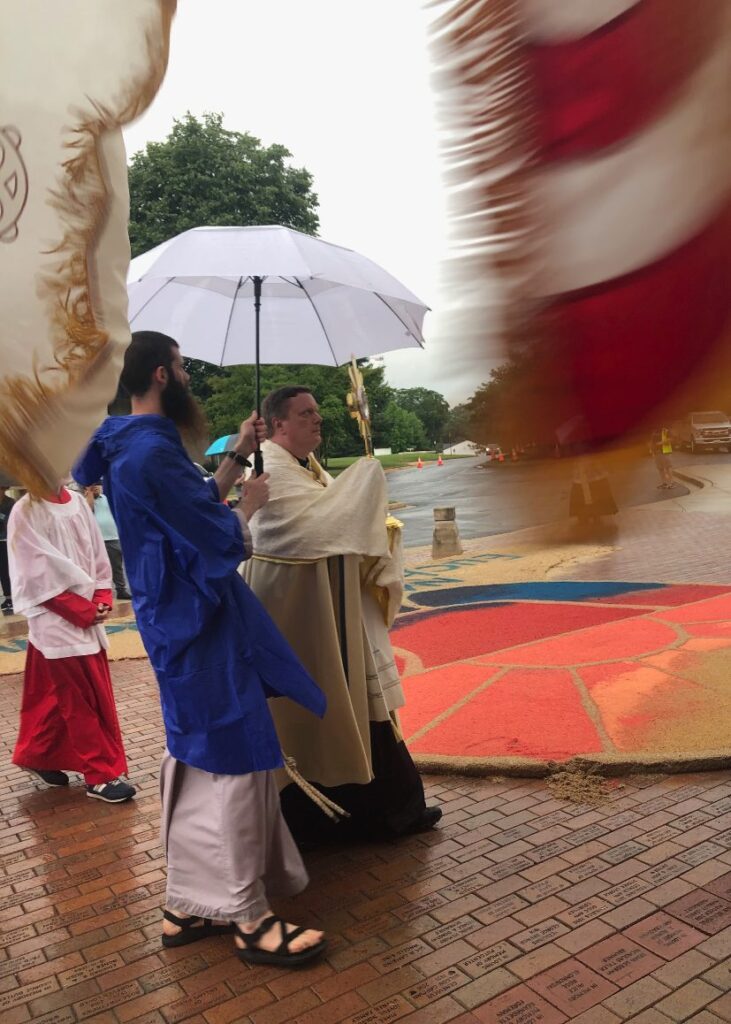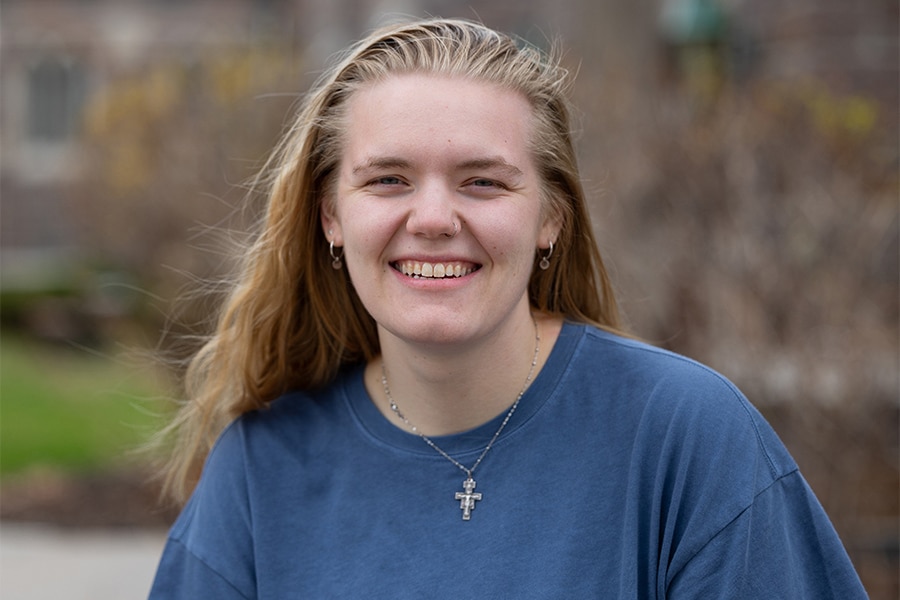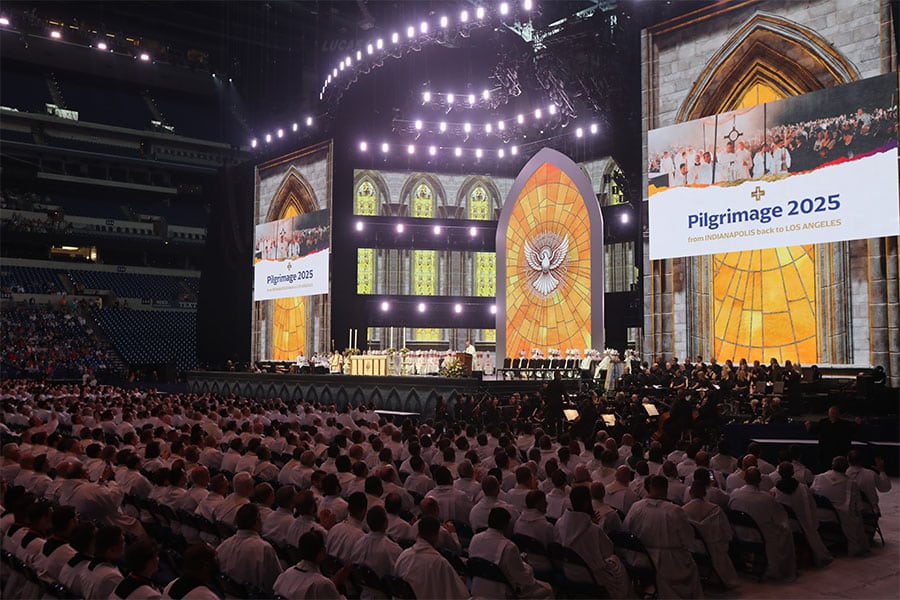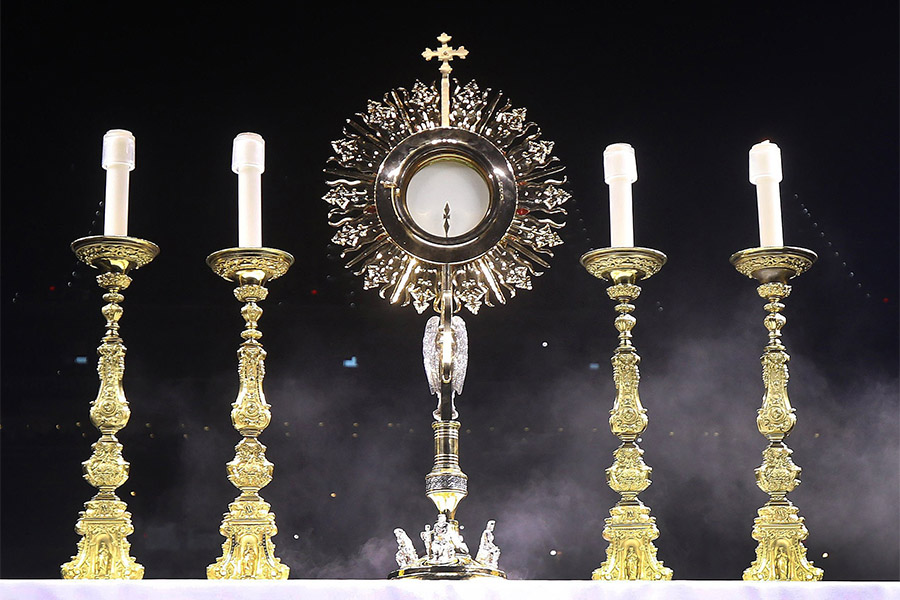
WESTMINSTER – The National Eucharistic Pilgrimage eastern route arrived in Maryland for three days of prayer, adoration and procession with a stop June 5 at St. John the Evangelist Parish in Carroll County.
The route – named for Maryland’s own St. Elizabeth Ann Seton, the first American-born saint – is one of four coming from all corners of the country to join up July 17 at the National Eucharistic Congress in Indianapolis.
More than 500 people gathered at the church to hear a brief talk by Father Roger Landry, one of 56 eucharistic preachers in the U.S., who is accompanying the pilgrims on the Seton route.
He said that the fathers of the Second Vatican Council used the phrase the “pilgrim church on earth” to refer to Catholicism. In Latin, the phrase is “the church making a pilgrimage on earth.” The National Eucharist Pilgrimage and its local stops are appropriate because “we are on a journey.”
“It’s a eucharistic pilgrimage because Jesus goes with us. Jesus doesn’t just journey on the outside. He wants to walk with us on the inside. The Catholic life is to walk with Jesus each day,” Father Landry said.
He addressed the concern that many Catholics, including those who attend Mass regularly, do not believe in the real presence of Jesus in the Eucharist. After the consecration, “There is no bread and wine at all, just the appearance of bread and wine. Jesus, out of love for us so we wouldn’t be repelled, hides in the appearance of bread and wine.”
He said this is the same Jesus who was in his mother’s womb, whom Joseph held in his arms, and who called St. Peter and the Apostles.
Father Landry said that this is why the U.S. bishops chose to respond to this crisis in education and faith about the Eucharist with a three-year National Eucharistic Revival.
“The only worship that makes sense is to offer all we have to him who offers all to us,” he said.
Father Mark Bialek, pastor of St. John, announced that the procession, originally planned to pass through the streets of Westminster, would circulate the parish campus only, due to some flooding from the rain. He noted that the city police department made the change just moments before the event for safety reasons.
Father Bialek lifted a monstrance containing the sacred host and led the procession out of the church. He was preceded by a Knights of Columbus color guard and the “permanent pilgrims” for the Seton route – six young lay people who are making the 65-day trek from Connecticut to Indiana. They were joined by eight novices from the Franciscan Friars of the Renewal who rotate into the pilgrimage on a weekly basis with others from their order.
A choir, altar servers, religious members in habits and clergy also walked in the solemn procession in front of the Eucharist held by Father Bialek, protected by a Franciscan friar carrying a white umbrella.
As the faithful streamed along, singing and praying, they passed a long walk of art made of colored sawdust, which Father Leandro Fazolini, associate pastor, and other members of the parish had completed around midnight the night before the pilgrimage. As the rain had already started to wash away some of the sawdust carpet, Father Fazolini had taken a few minutes before the event to fill in some of the gaps with shovels of wood chips.

Father Fazolini also carried the monstrance for part of the procession.
Even in the rain, the smell of incense wafted through the air, as the crowd made its way on a walk that lasted about 30 minutes.
Upon returning to the church, Father Bialek concluded the service with Benediction, before removing the host from the monstrance and reposing the Eucharist in the tabernacle.
In an interview before the procession, Father Landry told the Catholic Review that so far, the pilgrimage had been “a 19-day retreat in which I have several hours of prayer each day.”
Each of the four national pilgrimage routes always has a priest accompanying it. For most of the routes, priests – mostly from the Franciscan Friars of the Renewal – rotate in and out on a weekly basis. Father Landry said he was fortunate his duties as Catholic chaplain at Columbia University ended for the year just before the pilgrimage started. The Seton route is the only one to have the same priest for all 65 days.
He said the pilgrimage is seeing the best of the church in the United States, historically and pastorally. Some of the sites they have visited are among the oldest and most notable churches in the country. But they have also walked the streets of cities and towns throughout the Northeast.
“We have been visiting some of the churches built by the eucharistic faith of generations of hard-working (Catholics), mostly immigrants. … Up until this pilgrimage began, I anticipated I would be a witness to the Real Presence of Jesus and the Blessed Sacrament, the greatest gift in the world,” he said.
He said he realized as the program has been going on, it has been having a great impact, as people with a vibrant faith have come out to meet the Lord, often with tears in their eyes.
The pilgrimages are targeted to three audiences. The first is for those who already have faith and need to be able to share that with others. “They are so grateful for the Eucharistic Revival in the church in the U.S. because it is living out what they had always hoped,” Father Landry said.
The second group is Catholics who need to be upgraded about their knowledge of the Real Presence of Christ in the Eucharist. The third group is passersby who have an opportunity “to see people doing something that may look crazy, at least in their eyes,” he said. Those people may realize that either these people are crazy to carry a piece of bread through the streets, or they are right and they are walking around with the same Jesus who was in Mary’s womb, he said.
Father Landry – a priest of the Diocese of Fall River, Mass., who is on loan to the Archdiocese of New York for his work at Columbia – said the National Eucharist Pilgrimage was partly his idea. At a conference including the eucharistic preachers in April 2022, he suggested the idea to Bishop Andrew Cozzens of Crookston, Minn., who chairs the National Eucharistic Revival. The bishop said he had also considered the idea but deemed it impractical.

As the preachers discussed the idea among themselves, they were excited about the possibility. Franciscan Friar of the Renewal John Boughton, now superior of the order, said that if one of the practical concerns was ensuring a priest would be available 24/7 for each route, his order would commit to providing the priests needed. With that assurance, Father Landry said, Bishop Cozzens took the idea to the body of bishops for approval.
Father Landry is not the only one to make a long-term commitment to the pilgrimage. Each of the permanent pilgrims, selected for their strong faith already, joined the walk to be closer to Jesus and the people they encounter along the way. Each went through an application and interview process to be selected.
Amayrani Higueldo, 26, who just completed nursing school, said she learned about the opportunity to spend “two months with Jesus. Absolutely, I’m there.”
The native of Mexico who now lives in the Archdiocese of Philadelphia was concerned that just having finished school, she needed to find a job and earn some money, “but the Lord just kept tugging at my heart, so I sent in the application and here I am walking two whole months with the Lord,” she said.
Zoe Dongas, 25, who is originally from Nashville, Tenn., but now lives in New York City, heard about the National Eucharistic Revival, Congress and Pilgrimage all at the same time. She has wanted to walk the Camino de Santiago in Spain, but said this sounded like an “American camino.”
“A road trip with Jesus sounds like a pretty awesome opportunity, and it certainly answered desires on my heart for adventure and for more time with Jesus,” Dongas said.
No day has been the same for the pilgrims. Some days have seen them walking through countryside or city streets. They have encountered rain – a deluge far more than they dealt with in Westminster – and heat. One day, they walked 17 miles in the hot sun. Dongas got her first blister about a week before the Maryland stop. They took advantage of a lighter travel day by napping under a tree outside the St. John rectory before events of the evening.
The total eastern route is about 1,200 miles, but part of that will be covered in a vehicle, in which the Blessed Sacrament is reposed in a monstrance while they travel. Dongas and Higueldo said they expect to walk about 800 miles by the time they get to Indianapolis.
They both say they have experienced great generosity from the people they meet along the way. Often, the parishioners where they stop provide them with snacks and plenty of food and drinks.
They also have a great sense of joy while walking and helping people see Jesus. Dongas noted that she spoke with a man experiencing homelessness in Philadelphia’s Kensington neighborhood. She invited him to join the procession, but he didn’t want to leave behind his belongings. She asked if there was anything he wanted her to pray for, and he gave some suggestions. The procession route took the group back along the same street, and she realized that others in the group had also stopped to talk with the man, whose face was now brighter for having seen the face of Jesus in others.
Higueldo said she has learned much about herself in the early weeks of the pilgrimage. She also learned “our Lord is so much bigger than what I think he is. I put him in a little box sometimes, so just getting that experience just to see how big he truly is in the hearts of these people (has) been amazing to witness,” she said.
Email Christopher Gunty at editor@CatholicReview.org
Also see
Copyright © 2024 Catholic Review Media








